Synchronization-Free RadChat for Automotive Radar Interference Mitigation †
Abstract
1. Introduction
2. System Model and Assumptions
2.1. Radar Communications Model
2.2. Propagation Channel Model
3. Sync-Free Radchat: Protocol Description
3.1. Background: Basics of the RadChat Protocol
3.2. Synchronization-Free RadChat
3.2.1. Design Parameters
3.2.2. Scheduling
3.2.3. Maximum Available Resources
4. Performance Evaluation and Results
4.1. Scenario and Parameters
4.2. Maximum Available Resources versus Synchronization Error
4.3. Convergence Latency and Blind Duration
4.4. Fraction of Blinds
5. Conclusions
Author Contributions
Funding
Institutional Review Board Statement
Informed Consent Statement
Data Availability Statement
Conflicts of Interest
References
- Aydogdu, C.; Keskin, M.F.; Garcia, N.; Wymeersch, H.; Bliss, D.W. RadChat: Spectrum sharing for automotive radar interference mitigation. IEEE Trans. Intell. Transp. Syst. 2019, 22, 416–429. [Google Scholar] [CrossRef]
- Petrov, V.; Fodor, G.; Kokkoniemi, J.; Moltchanov, D.; Lehtomaki, J.; Andreev, S.; Koucheryavy, Y.; Juntti, M.; Valkama, M. On unified vehicular communications and radar sensing in millimeter-wave and low terahertz bands. IEEE Wirel. Commun. 2019, 26, 146–153. [Google Scholar] [CrossRef]
- Hasan, K.F.; Feng, Y.; Tian, Y. GNSS time synchronization in vehicular ad hoc networks: Benefits and feasibility. IEEE Trans. Intell. Transp. Syst. 2018, 19, 3915–3924. [Google Scholar] [CrossRef]
- GPS Clock Synchronization. Available online: https://www.orolia.com/resources/knowledge-center/gps-clock-synchronization (accessed on 30 September 2020).
- Hussein, S.; Krings, A.; Azadmanesh, A. VANET clock synchronization for resilient DSRC safety applications. In Proceedings of the 2017 Resilience Week (RWS), Wilmington, DE, USA, 18–22 September 2017; pp. 57–63. [Google Scholar]
- Li, Z.; Ding, Z.; Wang, Y.; Fu, Y. Time synchronization method among VANET devices. In Proceedings of the 2017 International Conference on Wireless Communications, Signal Processing and Networking (WiSPNET), Chennai, India, 22–24 March 2017; pp. 2096–2101. [Google Scholar]
- Liang, J.; Wu, K. An extremely accurate time synchronization mechanism in fog-based vehicular ad hoc network. IEEE Access 2020, 8, 253–268. [Google Scholar] [CrossRef]
- Ansere, J.A.; Han, G.; Wang, H. A novel reliable adaptive beacon time synchronization algorithm for large-scale vehicular ad hoc networks. IEEE Trans. Veh. Technol. 2019, 68, 565–576. [Google Scholar] [CrossRef]
- Haider, S.; Abbas, G.; Abbas, Z.H. VLCS: A novel clock synchronization technique for TDMA-based MAC protocols in VANETs. In Proceedings of the 4th International Conference on Emerging Trends in Engineering, Sciences and Technology (ICEEST), Karachi, Pakistan, 10–11 December 2019; pp. 1–6. [Google Scholar]
- Nasrallah, Y.Y.; Al-Anbagi, I.; Mouftah, H.T. Distributed time synchronization mechanism for large-scale vehicular networks. In Proceedings of the 2016 International Conference on Selected Topics in Mobile Wireless Networking (MoWNeT), Cairo, Egypt, 11–13 April 2016; pp. 1–6. [Google Scholar]
- Buller, W.; Wilson, B.; Garbarino, J.; Kelly, J.; Subotic, N.; Thelenand, B.; Belzowski, B. Radar Congestion Study; NHTSAreport (Report No. DOT HS 812 632); National Highway Traffic Safety Administration: Washington, DC, USA, 2018. [Google Scholar]
- Aydogdu, C.; Keskin, M.F.; Carvajal, G.K.; Eriksson, O.; Hellsten, H.; Herbertsson, H.; Nilsson, E.; Rydstrom, M.; Vanas, K.; Wymeersch, H. Radar Interference Mitigation for Automated Driving: Exploring Proactive Strategies. IEEE Signal Process. Mag. 2020, 37, 72–84. [Google Scholar] [CrossRef]
- Viriyasitavat, W.; Boban, M.; Tsai, H.; Vasilakos, A. Vehicular communications: Survey and challenges of channel and propagation models. IEEE Veh. Technol. Mag. 2015, 10, 55–66. [Google Scholar] [CrossRef]
- Liang, L.; Peng, H.; Li, G.Y.; Shen, X. Vehicular communications: A physical layer perspective. IEEE Trans. Veh. Technol. 2017, 66, 10647–10659. [Google Scholar] [CrossRef]
- Sarabandi, K.; Li, E.S.; Nashashibi, A. Modeling and measurements of scattering from road surfaces at millimeter-wave frequencies. IEEE Trans. Antennas Propag. 1997, 45, 1679–1688. [Google Scholar] [CrossRef]
- Al-Hourani, A.; Evans, R.J.; Kandeepan, S.; Moran, B.; Eltom, H. Stochastic geometry methods for modeling automotive radar interference. IEEE Trans. Intell. Transp. Syst. 2017, 19, 333–344. [Google Scholar] [CrossRef]
- Aydogdu, C.; Keskin, M.F.; Wymeersch, H. Automotive radar interference mitigation via multi-hop cooperative radar communications. In Proceedings of the EuMA European Microwave Association, 17th European Radar Conference EuRad 2020, Utrecht, The Netherlands, 10–15 January 2021. [Google Scholar]
- Aydogdu, C.; Garcia, N.; Wymeersch, H. Improved Pedestrian Detection under Mutual Interference by FMCW Radar Communications. In Proceedings of the IEEE International Symposium on Personal, Indoor and Mobile Radio Communications (PIMRC), Workshop on 5G V2X Communications for Connected Autonomous Driving, Bologna, Italy, 9–12 September 2018. [Google Scholar]
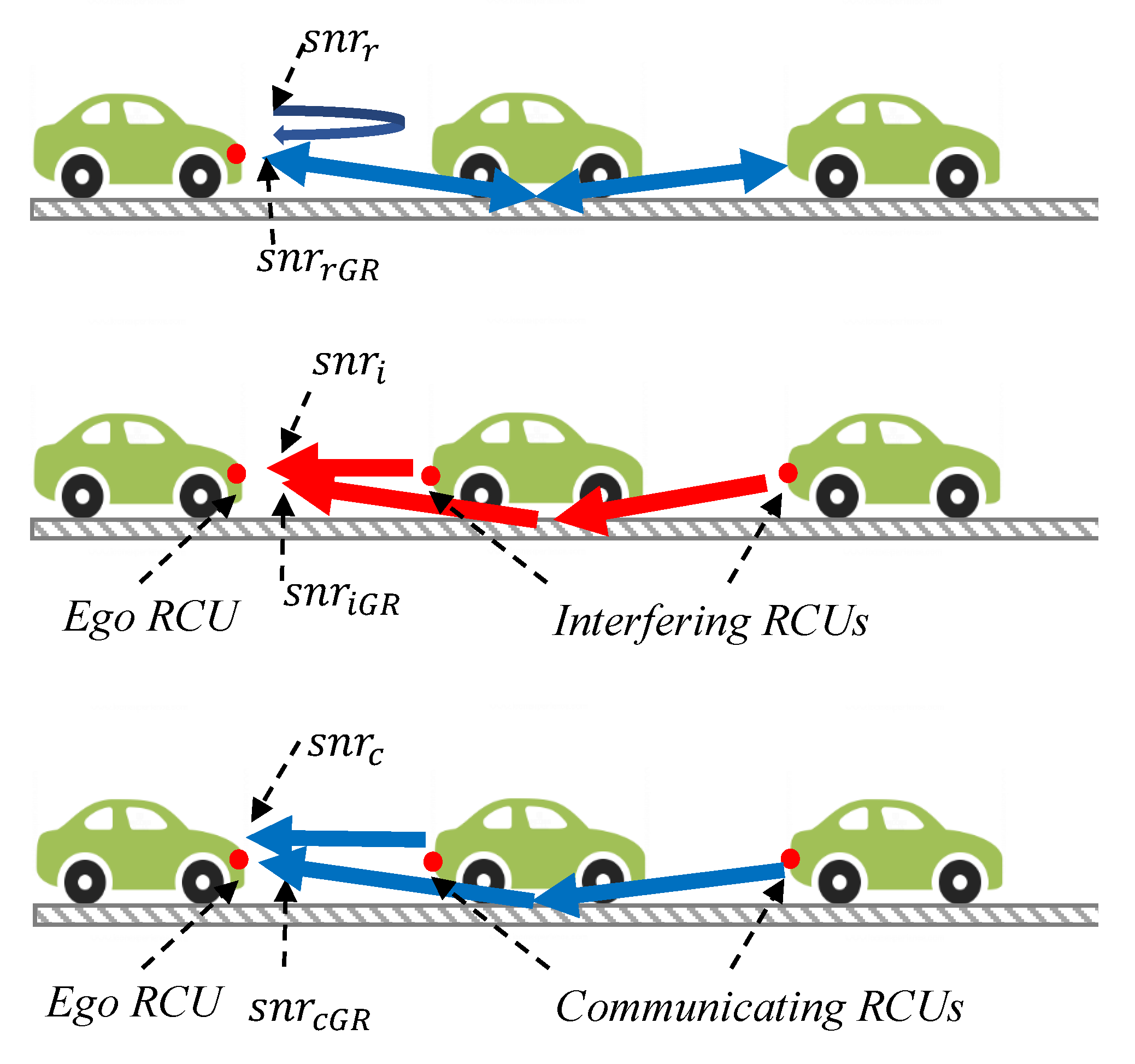
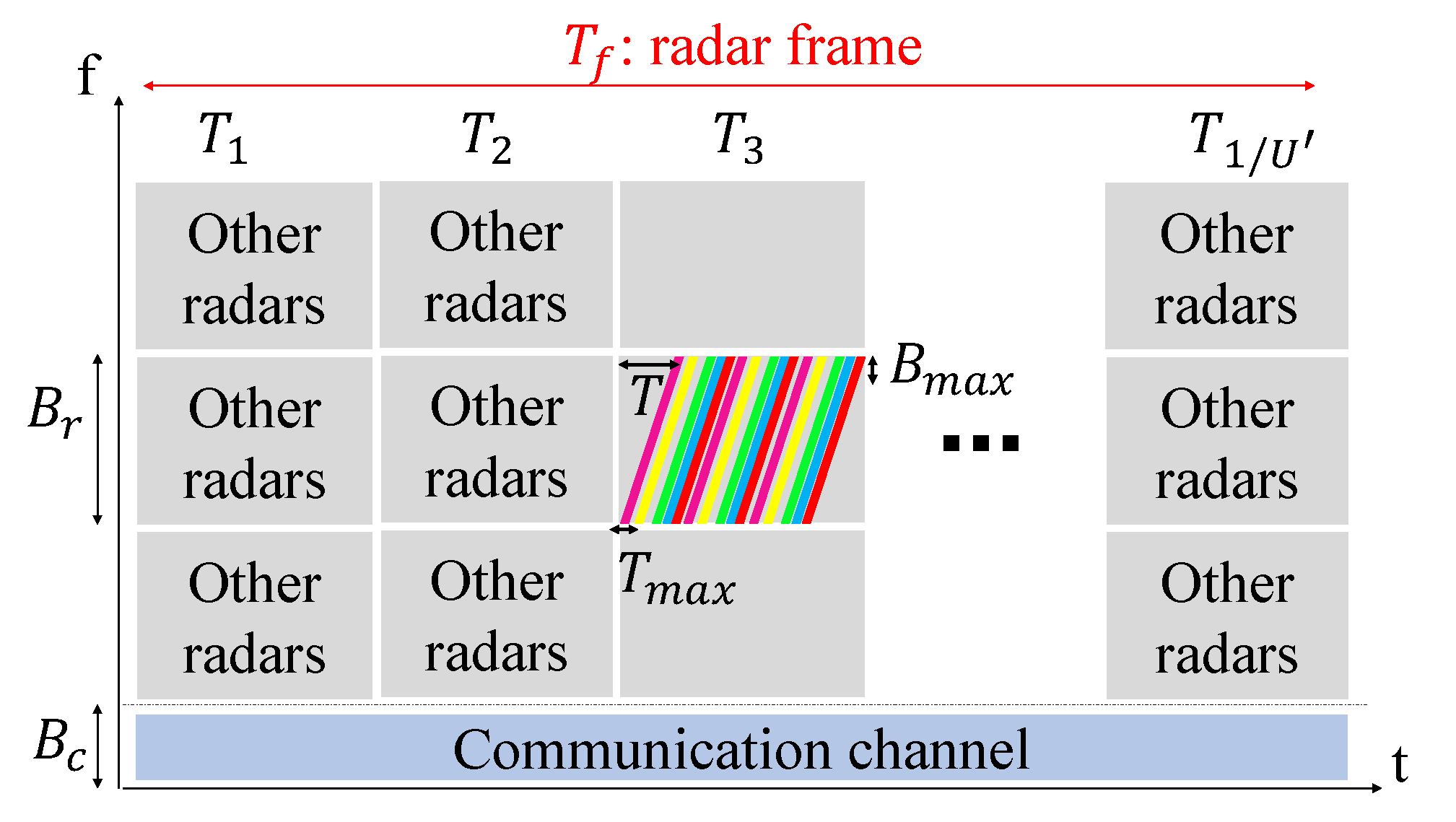
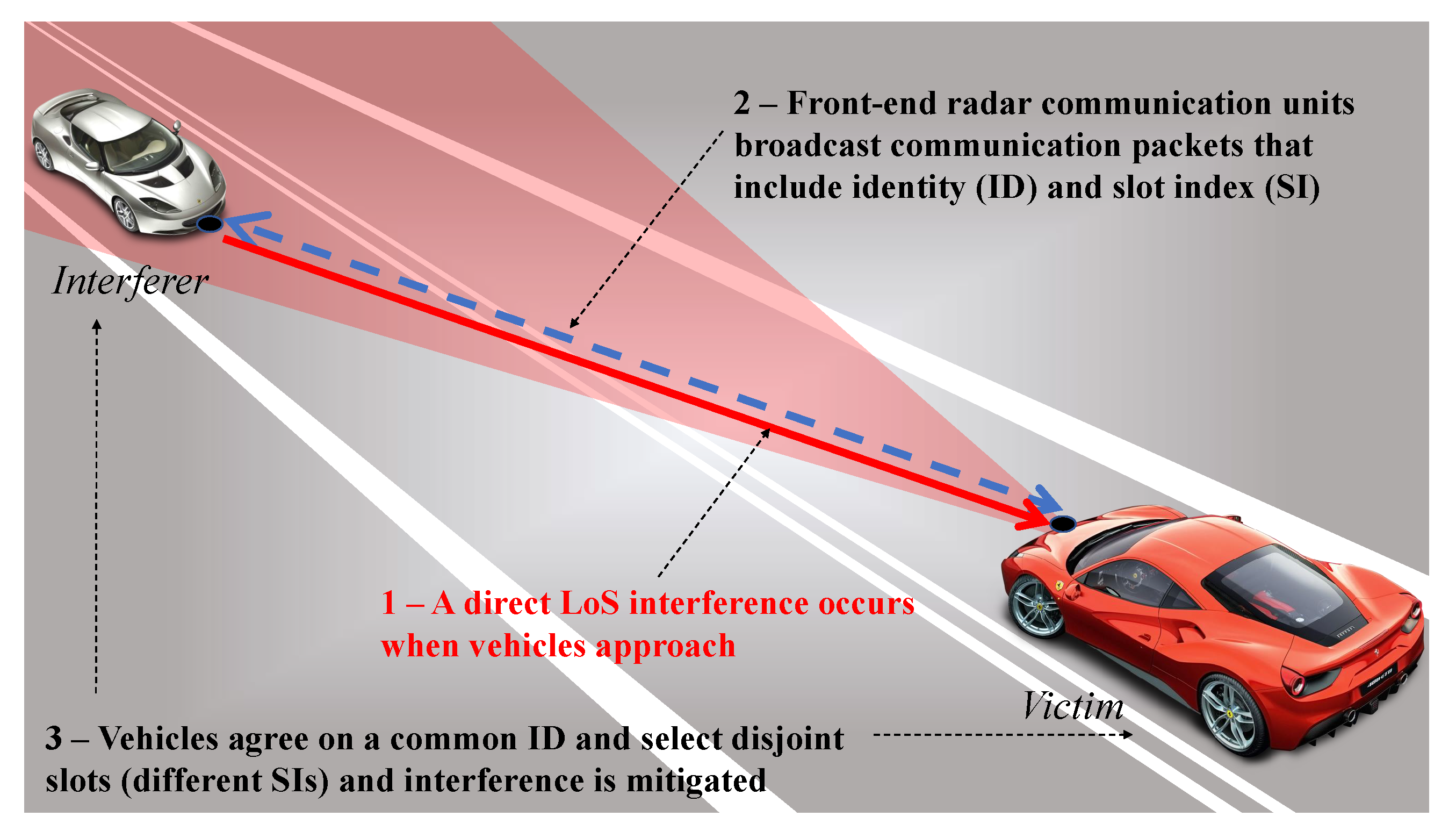
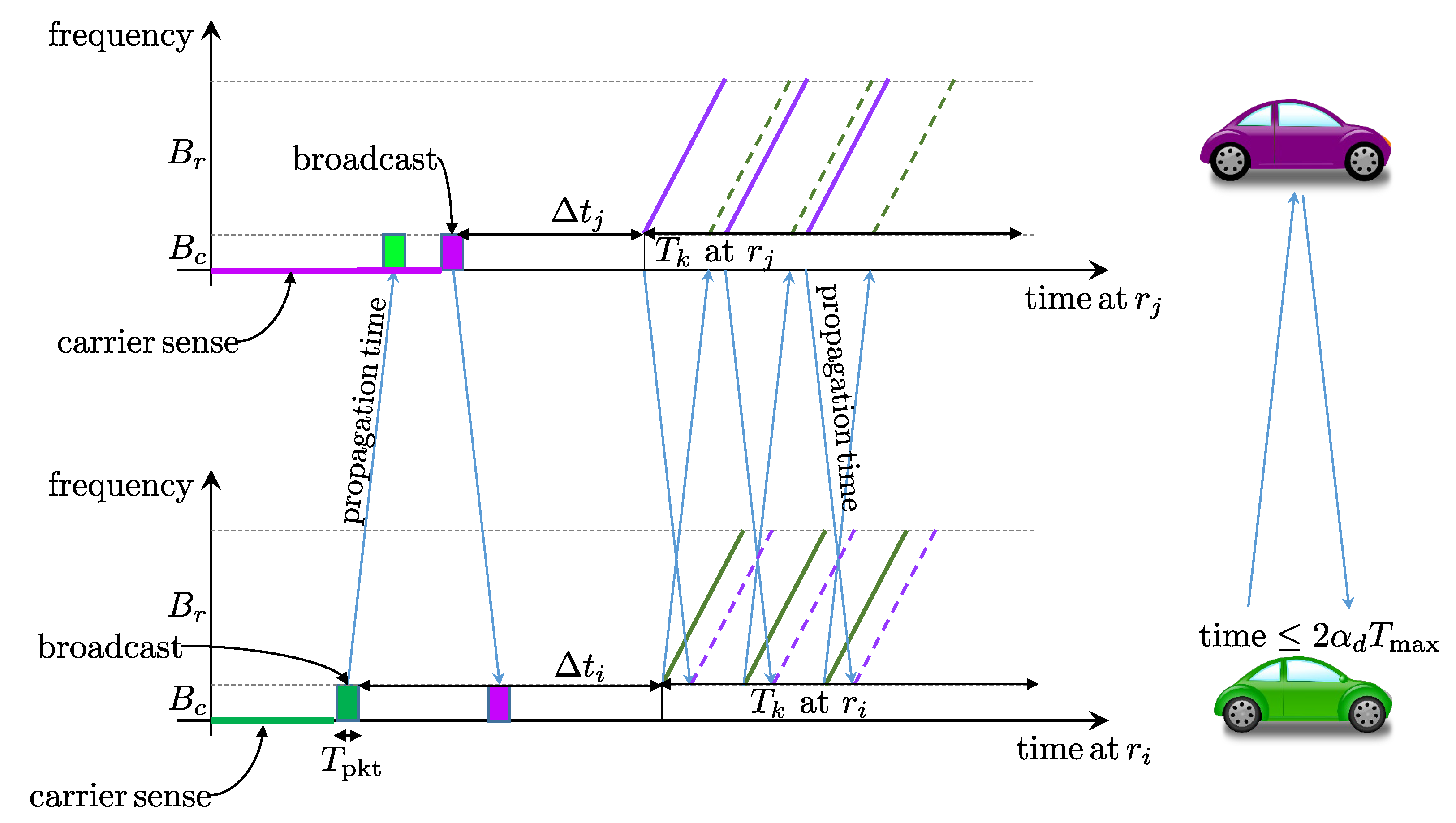
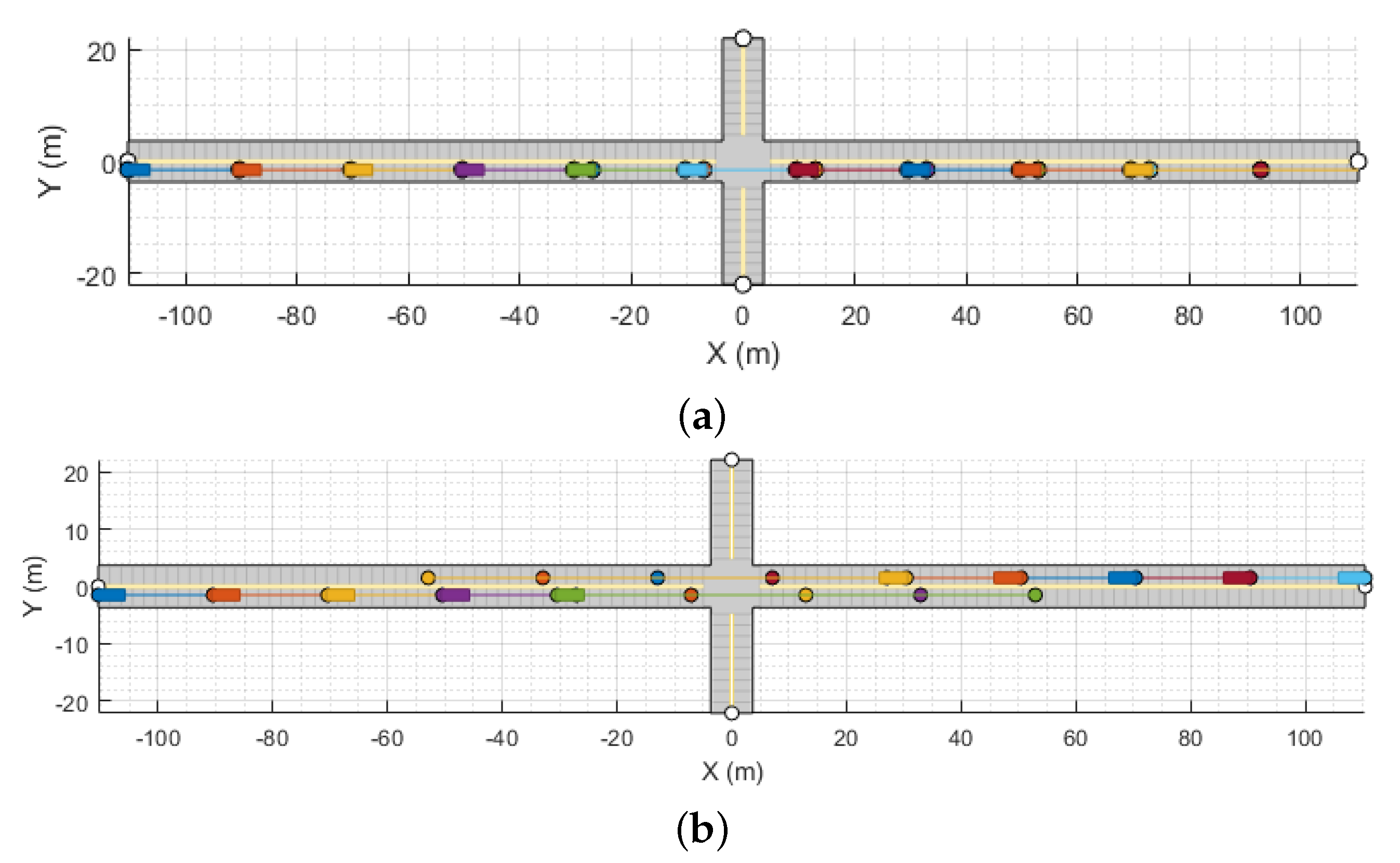
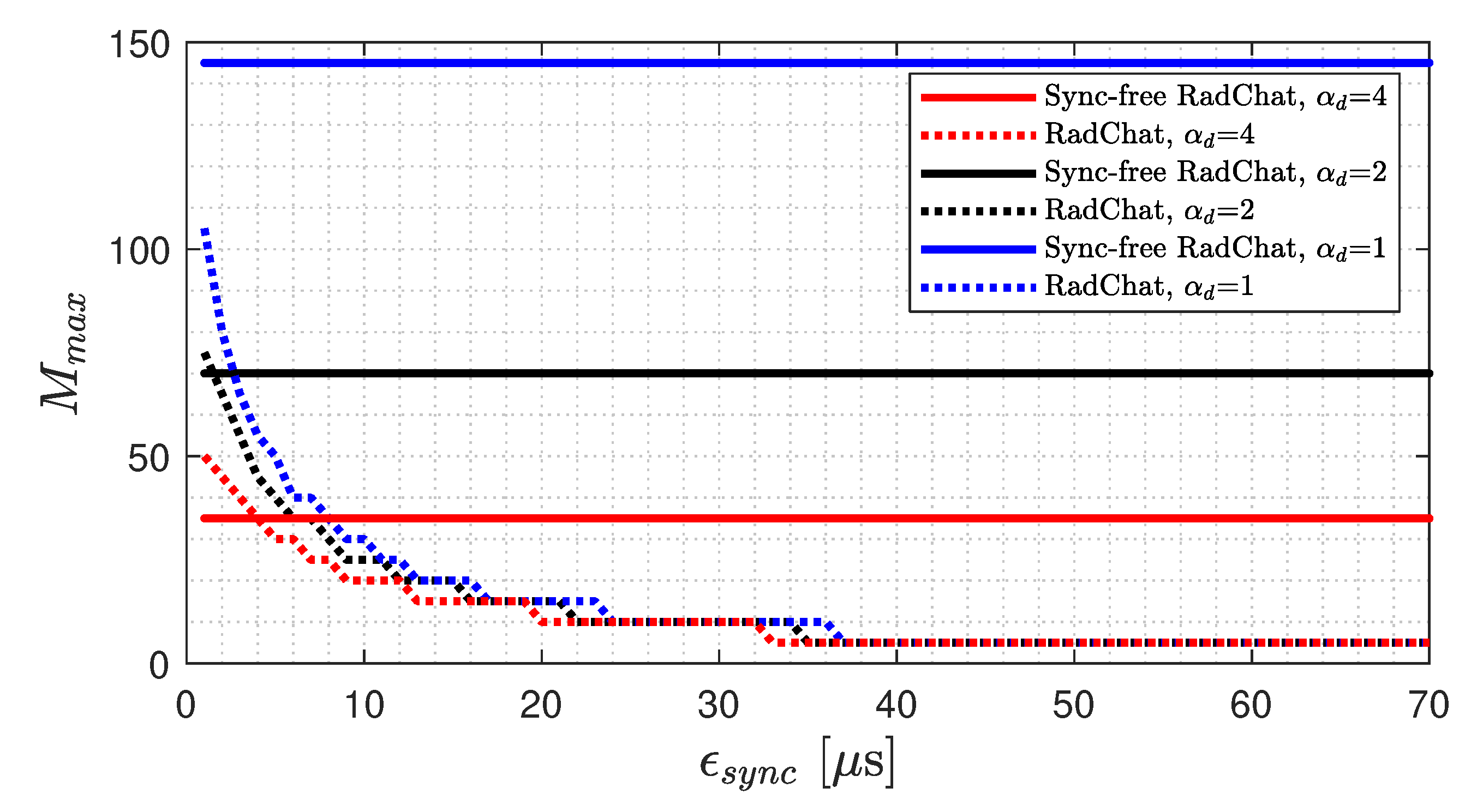
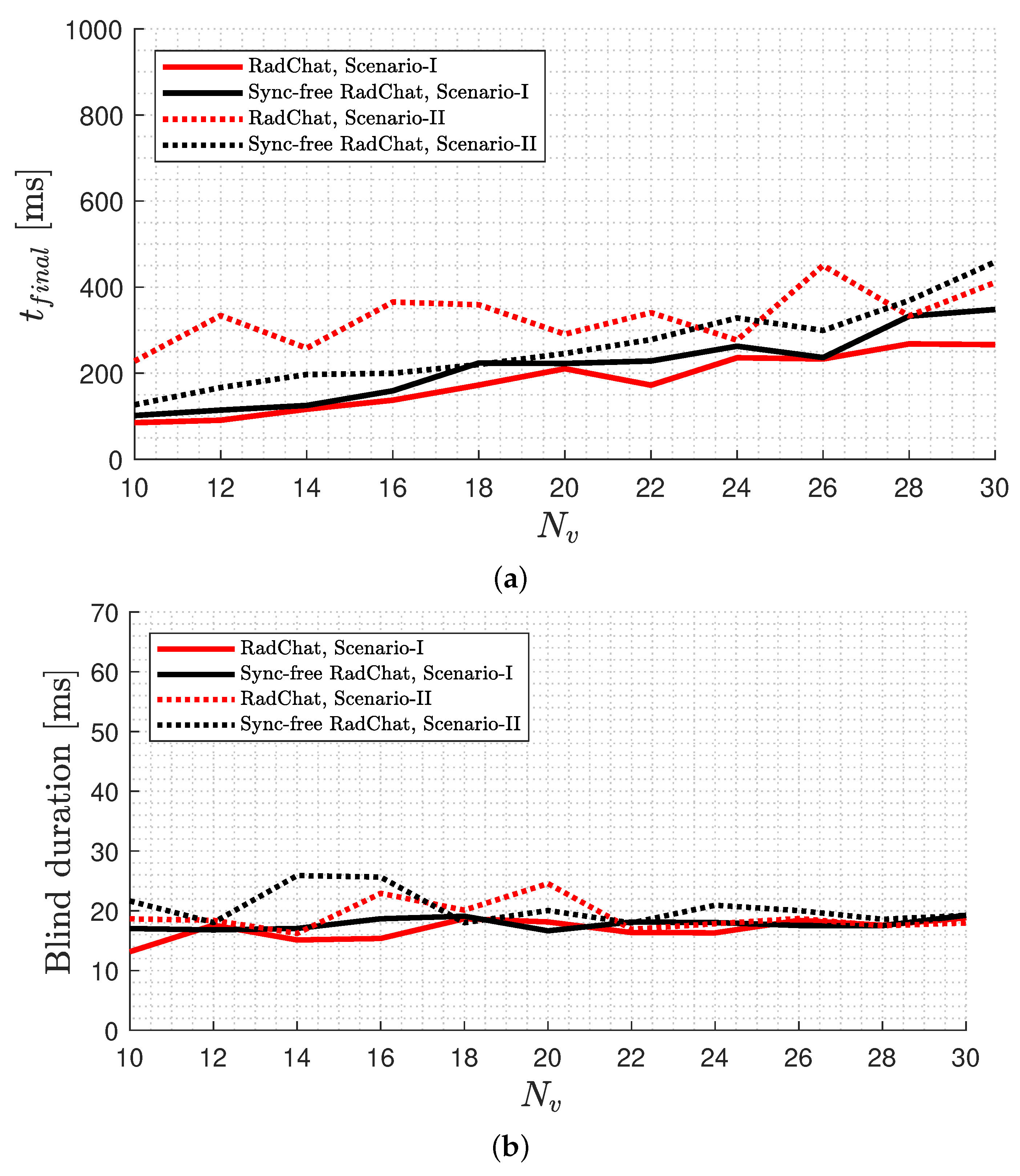
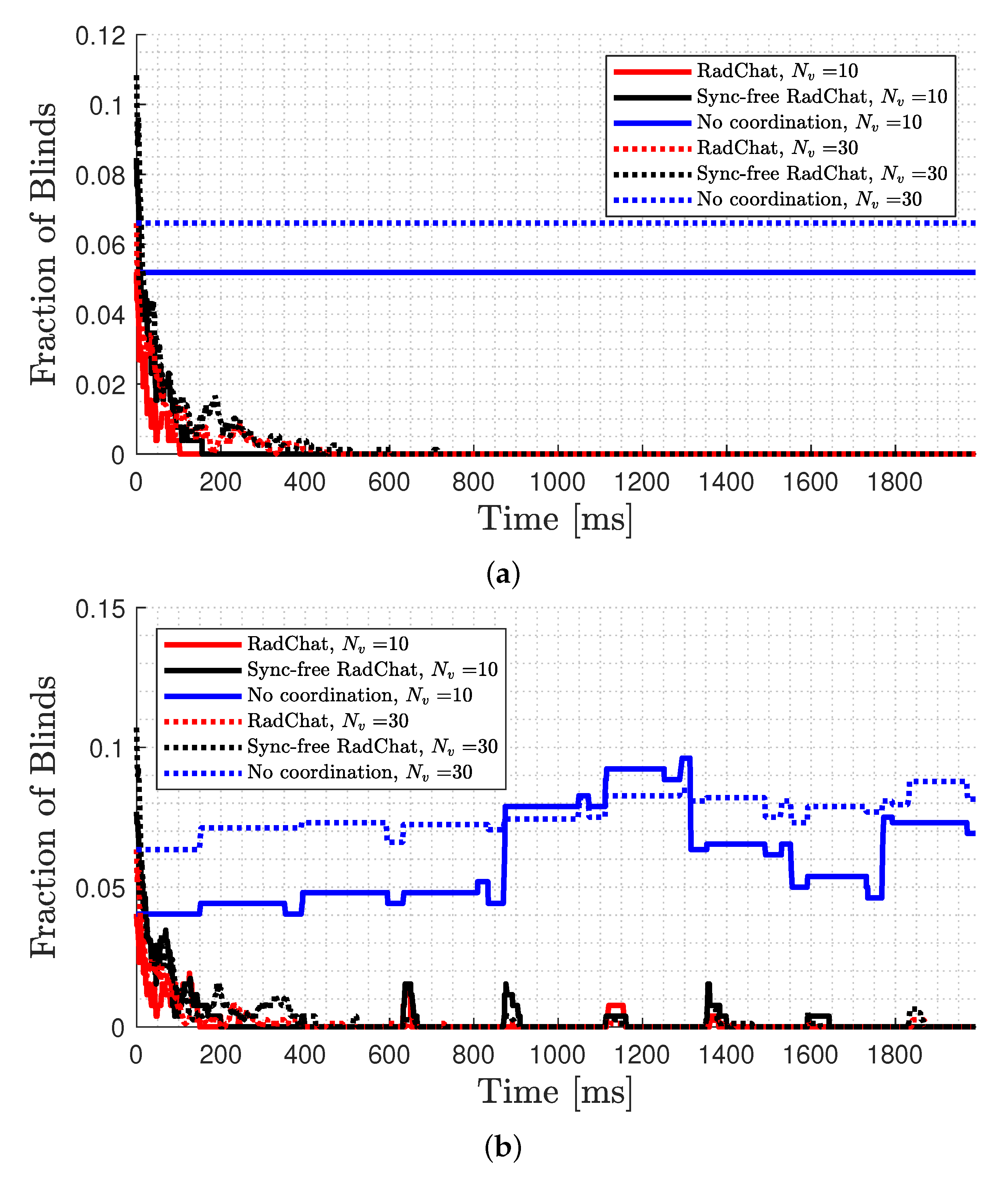

| Parameter | Explanation |
|---|---|
| B | Maximum backoff stage |
| Communication bandwidth | |
| Radar bandwidth of interest | |
| Radar bandwidth | |
| Radar ADC bandwidth | |
| Communication LoS range | |
| Communication range for one-way ground-reflected signals | |
| Radar LoS interference range | |
| Radar ground-reflected interference range | |
| Radar LoS range | |
| Radar range for two-way ground-reflected signals | |
| Radar processing gain | |
| Antenna gain | |
| Communication carrier frequency | |
| Carrier frequency | |
| ID | Identity of reference vehicle for RadChat |
| The maximum number of RCUs supported with RadChat | |
| The maximum number of RCUs supported with Sync-free RadChat | |
| N | Number of chirps per frame |
| Number of vehicles in the VANET | |
| Packet size | |
| Communication transmit power | |
| Radar transmit power | |
| R | Reflection Coefficient for asphalt |
| SI | SlotIndex, indication for timing of radar signals for RadChat |
| T | Chirp duration |
| Frame duration | |
| RadChat protocol convergence latency | |
| Maximum delay for (intended) radar reflections | |
| Transmission time of communication packet | |
| Thermal noise temperature | |
| Modified duty cycle | |
| V | Vulnerable period for RadChat |
| Vulnerable period for Sync-free RadChat | |
| Maximum contention window size | |
| Ratio of the furthest away communicated possible interferer range to | |
| radar round-trip range | |
| SlotTime | |
| Synchronization error for RadChat | |
| Radar signal-to-noise ratio threshold | |
| Vehicle radar cross-section |
| Parameter | Value | |
|---|---|---|
| Radar | Radar bandwidth () | 800 |
| ADC bandwidth () | 15 | |
| Carrier frequency () | ||
| Modified duty cycle () | 1/5 | |
| Vehicle radar cross-sections | 10 | |
| Radar transmit power | 12 | |
| Radar processing gain | ||
| Radar signal-to-noise ratio threshold | 7dB | |
| Chirp duration (T) | ||
| Frame duration () | 50ms | |
| Number of chirps per frame (N) | 128 | |
| Communication | Communication bandwidth | 15 |
| Communication carrier frequency () | ||
| Packet size () | 100 bytes | |
| Modulation | 16-QAM | |
| Communication transmit power | 23 | |
| SlotTime | 10 | |
| Maximum contention window size () | 48 | |
| Maximum backoff stage (B) | 3 | |
| Joint | Maximum distance of communicated interferer () | 1 km |
| Thermal noise temperature | 290 | |
| Receiver’s noise figure | 2 | |
| Antenna gain | 30dBi | |
| Reflection Coefficient for asphalt (R) | 0.2814 | |
| Antenna FoV | (azimuth), | |
| (elevation) |
Publisher’s Note: MDPI stays neutral with regard to jurisdictional claims in published maps and institutional affiliations. |
© 2021 by the authors. Licensee MDPI, Basel, Switzerland. This article is an open access article distributed under the terms and conditions of the Creative Commons Attribution (CC BY) license (https://creativecommons.org/licenses/by/4.0/).
Share and Cite
Aydogdu, C.; Wymeersch, H.; Eriksson, O.; Herbertsson, H.; Rydström, M. Synchronization-Free RadChat for Automotive Radar Interference Mitigation. Sustainability 2021, 13, 6891. https://doi.org/10.3390/su13126891
Aydogdu C, Wymeersch H, Eriksson O, Herbertsson H, Rydström M. Synchronization-Free RadChat for Automotive Radar Interference Mitigation. Sustainability. 2021; 13(12):6891. https://doi.org/10.3390/su13126891
Chicago/Turabian StyleAydogdu, Canan, Henk Wymeersch, Olof Eriksson, Hans Herbertsson, and Mats Rydström. 2021. "Synchronization-Free RadChat for Automotive Radar Interference Mitigation" Sustainability 13, no. 12: 6891. https://doi.org/10.3390/su13126891
APA StyleAydogdu, C., Wymeersch, H., Eriksson, O., Herbertsson, H., & Rydström, M. (2021). Synchronization-Free RadChat for Automotive Radar Interference Mitigation. Sustainability, 13(12), 6891. https://doi.org/10.3390/su13126891






